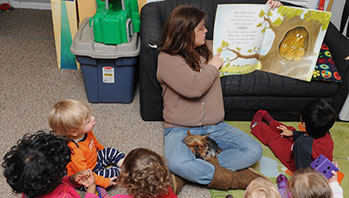- a selection of Chinese vegetables featured in the book
- Chinese
- garden
- ugly
- vegetable
MA Standards:
Literature/RL.PK.MA.1: With prompting and support, ask and answer questions about a story or a poem read aloud.
Literature/RL.PK.MA.4: With prompting and support, ask and answer questions about unfamiliar words in a story or poem read aloud.
RL.PK.MA.10: Listen actively as an individual and as a member of a group to a variety of age-appropriate literature read aloud.
Head Start Outcomes:
Literacy Knowledge/Book Appreciation and Knowledge: Asks and answers questions and makes comments about print materials.
PreK Learning Guidelines:
English Language Arts/Reading and Literature 6: Listen to a wide variety of age appropriate literature read aloud.
English Language Arts/Reading and Literature 10: Engage actively in read-aloud activities by asking questions, offering ideas, predicting or retelling important parts of a story or informational book.
Read Together: The Ugly Vegetables #1

© Commonwealth of Massachusetts, Department of Early Education and Care (Jennifer Waddell photographer). All rights reserved.
STEM Key Concepts: Many foods that animals, including humans, eat come from plants; We eat certain leaves, roots, fruits, and seeds; Plants exhibit diversity and variation
ELA Focus Skills: Appreciating Diversity, Compare and Contrast, Concepts of Print, Listening and Speaking, Predicting, Sequencing, Story Comprehension, Vocabulary
Before You Read
Show children the book cover and ask them to point out the title. Read the title aloud. Then ask children to describe the illustration. Ask children if they know what the word ugly means; then ask,
- Have you ever seen any vegetables that you thought were ugly? What was it about the vegetable that was ugly to you? Encourage children to use descriptive vocabulary in their responses.
- Then say, Today we’re going to read about a girl who wishes her mother’s garden was beautiful like all her neighbors’ gardens.
Set a reading focus by having children listen to understand why the little girl thinks her garden is ugly compared to her neighbors’ gardens and to see if they agree with the little girl.
As You Read
Read slowly and with expression. Ask questions that help children think about what is happening in the story. For example,
- Pause on the page with the seed packets. Ask, How are the seed packets different from the papers with the Chinese vegetable names?
- Pause on the page when the gardens are all in bloom. Ask, Why do you think the little girl thinks the other gardens are beautiful and hers is ugly? Which ones do you think are beautiful? Ugly? Why do you think that?
- Why do you think Mommy said, “These are better than flowers”?
After You Read
Talk about the story with children. Ask questions such as,
- Did you like this story? Why or why not?
- Why do you think it was hard for the little girl to think her garden was beautiful?
- Do you think the neighbors were glad to learn about different vegetables? Why do you think that?
- What is different about the plants in the little girl’s garden and the plants in the neighbors’ gardens?
- How are the plants in the little girl’s garden the same or different from the vegetables we planted?
If possible, take this opportunity to show children real-life examples of vegetables featured in the book. Allow children to touch, smell, and taste the vegetables.
English Language Learners: Encourage children who are familiar with any of the vegetables described in the book to tell others about the vegetables. Guide them to talk about the shape, color, and texture of the vegetables, what they taste like, and what kinds of dishes they are used in.
Social Emotional Tip: Point out that people in different families eat different foods. Ask, Why might it be important to discover what kinds of foods other people eat? Encourage children to connect the idea that to learn about what different people eat helps us to learn about the people of the world.
